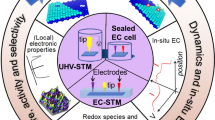Abstract
THE scanning tunnelling microscope1 (STM) has been employed in recent years in attempts to develop atomic-scale electronic devices, both by examining device-like characteristics in preexisting structures2,3 and by creating new structures by the precise manipulation of atoms and molecules with the STM tip4–6. Here we report the operation of a bistable switch that derives its function from the motion of a single atom. A xenon atom is moved reversibly between stable positions on each of two stationary conducting 'leads', corresponding to the STM tip and a nickel surface. The state of the switch is set (that is, the xenon atom is moved to the desired location) by the application of a voltage pulse of the appropriate sign across the leads. The state of the switch is identified by measuring the conductance across the leads. This switch is a prototype of a new class of potentially very small electronic devices which we will call atom switches.
Similar content being viewed by others
References
Hansma, P. K. & Tersoff, J. J. appl. Phys. 61, R1–R23 (1987).
Lyo, I.-W. & Avouris, P. Science 245, 1369–1371 (1989).
Bedrossian, P., Chen, D. M., Mortensen, K. & Golovchenko, J. A. Nature 342, 258–260 (1989).
Eigler, D. M. & Schweizer, E. K. Nature 344, 524–526 (1990).
New Scientist 129, 20 (23 Feb. 1991).
New Scientist 26, 31 (26 Jan. 1991).
Becker, R. S., Golovchenko, J. A. & Swartzentruber, B. S. Nature 325, 419–421 (1987).
Fuchs, H. & Schimmel, T. Adv. Mater. 3, 112–113 (1991).
Mamin, H. J., Guethner, P. H. & Rugar, D. Phys. Rev. Lett. 65, 2418–2421 (1990).
Whitman, L. J., Stroscio, J. A., Dragoset, R. A. & Celotta, R. J. Science 251, 1206–1210 (1991).
Lyo, I.-W. & Avouris, P. Science 253, 173–176 (1991).
Haberland, H., Kolar, T. & Reiners, T. Phys. Rev. Lett. 63, 1219–1222 (1989).
Eigler, D. M., Weiss, P. S., Schweizer, E. K. & Lang, N. D. Phys. Rev. Lett. 66, 1189–1192 (1991).
Ralls, K. S., Ralph, D. C. & Buhrman, R. A. Phys. Rev. B40, 11561–11570 (1989).
Verbruggen, A. H. IBM J. Res. Dev. 32, 93–98 (1988).
Landauer, R. Physica A168, 75–87 (1990).
Author information
Authors and Affiliations
Rights and permissions
About this article
Cite this article
Eigler, D., Lutz, C. & Rudge, W. An atomic switch realized with the scanning tunnelling microscope. Nature 352, 600–603 (1991). https://doi.org/10.1038/352600a0
Received:
Accepted:
Issue Date:
DOI: https://doi.org/10.1038/352600a0
- Springer Nature Limited
This article is cited by
-
Anisotropic monolayer of ReX2 on Au foils for exploring abnormal growth behavior and electronic properties
Nano Research (2023)
-
Bridging microscopy with molecular dynamics and quantum simulations: an atomAI based pipeline
npj Computational Materials (2022)
-
Li@C60 as a multi-state molecular switch
Nature Communications (2019)
-
Creating designer quantum states of matter atom-by-atom
Nature Reviews Physics (2019)
-
Space-confined growth of monolayer ReSe2 under a graphene layer on Au foils
Nano Research (2019)





